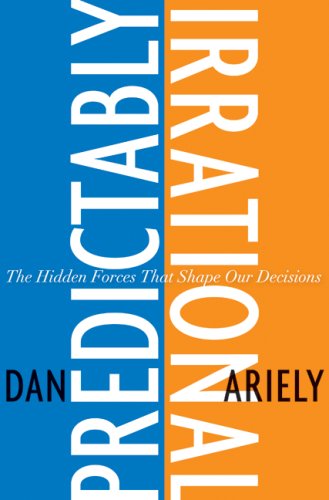Predictably Irrational, a book by MIT professor Dan Ariely, uncovers the hidden forces that shape our decisions. It is such a fun read that I finished the book in 2 days. The book teaches the reader about psychology and how it manifests in everyday life.
- People don't know what they want unless the options are presented in context. Price the item you want to sell in the middle of the price ranges presented. It takes less thinking to choose the middle-priced item. He found that adding higher priced items on a menu will increase overall restaurant revenue even if those high-priced items are never ordered. Bring a "wing-man" who is less attractive than you when going out to a club to meet potential mates.
- Anchoring has a major long-term effect on our willingness to pay. Students were asked to write down the last two digits of their SSN before choosing a price for a random item would tend to pay higher if their SSN was a higher number. House buying has the same effect, those moving to more expensive areas squeeze into a small house, while those moving to cheaper areas buy a mansion, regardless of their actual space necessities. Knowing the impact of anchoring, train oneself to question repeated behaviors. And pay particular attention to the first decision in a long stream of decisions. While it may seem like just one decision, it has an impact on future decisions for years to come.
- "Free" makes us perceive what is being offered as immensely more valuable than it really is. People will wait in line for absurdly long times to get something for free. And free is one of the most powerful ways to trigger behavior This is because we are loss averse. Say we increase our happiness by 5 units when we win $10, when we lose $10, we should logically reduce our happiness by 5 units, but in reality we decrease our happiness by more than 5 units.
- Above is the reason we overvalue what we own. This is called the "endowment effect." When we own something, we begin to value it more than other people do.
- Getting paid to do something triggers 'market norm' where as doing something for free triggers 'social norm'. And people will often work harder under non-monetary social norms than for payment! For example, when AARP asked lawyers to work for $30/hr representing the needy, no one signed up, but when asked to work for free, an overwhelming number did. It's helpful to know that small gifts don't constitute a market norm, and keep things in the social realm. Companies that market based on social norms ("like a good neighbor...") but fail to follow through (e.g. imposing nuisance fees) are violating a social contract with their customers, who may take personal offense when a relationship framed as a social exchange turns out to be a market one.
A really good detailed summary of the book can be found
here.



